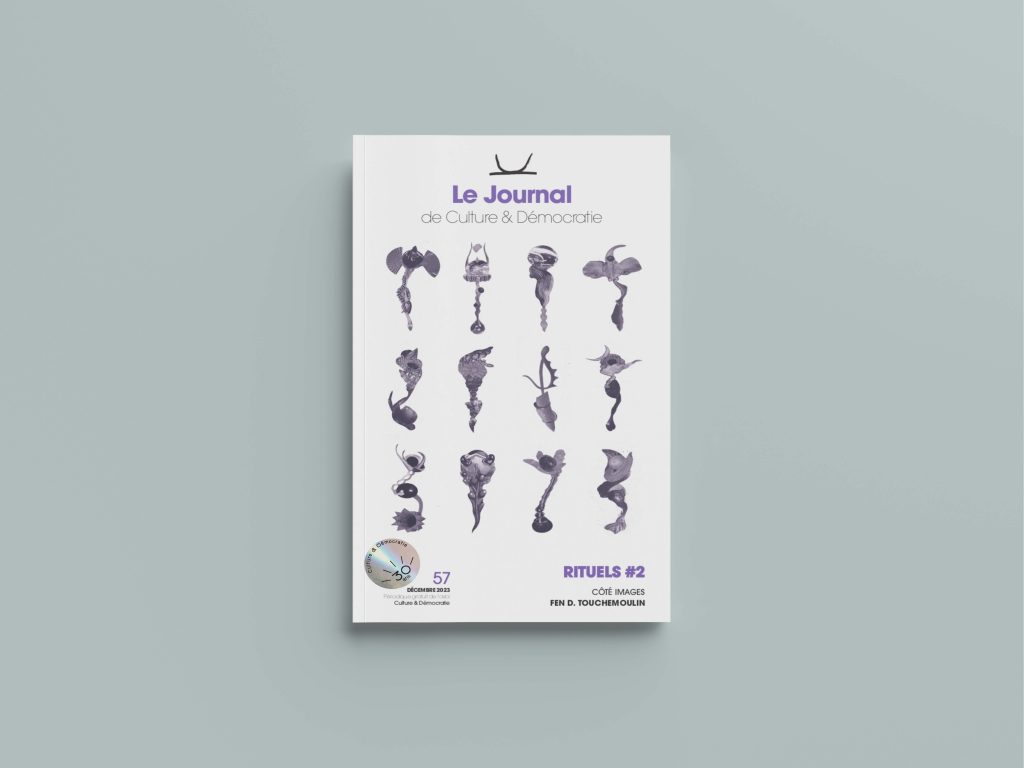Rituals as collective practices: why rituals offer solutions to the problems of our rationalist age; an example of ritualism cum eco-activism; artivism and AIDS campaigning in the 90s; and how sorcery can save the planet.
What is the place and power of rituals today? On its 30th anniversary, Culture & Démocratie devotes a second issue to rituals and their benefits as fictions that ‘reinforce a culture of the commons’.
The issue presents a startling array of rituals. Although rituals are not intrinsically positive – they can also be used to conjure illiberalism and hate – the forms of this secular magic described are benevolent. As collective practices, they stress the need for a culture of the commons, and for change based on ‘collective intelligence, DNA of democracy’.

Rituals and rationalism
In the past, rituals ‘mobilized symbolism to represent the irrepresentable’, writes Pierre Hemptinne. They were a tool to grasp what escaped us, to confront what we couldn’t master and need protection from.
But in the present, humankind is suffering ‘the consequences of a large-scale rejection of the irrepresentable’, a product of ‘capitalism’s rational materialism’. Cut off from the invisible and the immaterial, we are left in a state of eco-anxiety, ill-prepared to navigate a menacing future.
The conditions are ripe for creating new knowledge, beliefs and stories to guide us towards ‘unprecedented solutions’. But for these to take root, some kind of ceremony is needed: ‘rituals that intertwine the energies, convictions, hopes, knowledge and know-how of all people.’
Activism
Jay Jordan writes about the fight to defend a rural commune in western France, Notre-Dame-des-Landes, from being developed into an airport. In the 1970s, farmers there had refused to sell their land to the state, but the planners pushed ahead. By 2008, some land and buildings had been left empty. A handful of activists settled there, and the zone à défendre (ZAD) was born.
Each time the ZAD community was threatened with expulsion, tens of thousands of supporters would show up to blockade the site. In February 2016, sixty thousand people partied on the stretch of motorway where the bulldozers were meant to start digging. ‘These actions worked like rituals, spells to build the collective energy and focus it on a clear intention: preventing the expulsions.’
The government eventually ceded but, out of spite, sent in police, helicopters and tanks to destroy the ZAD. Abandoning the site and accepting the state’s conditions led to rifts and conflict among the activists.
A year later, in 2019, Jordan and three others set out to use ‘the power of ritual as a tool of ‘care’ for their community’. With giant puppets, songs and fire the group acted out the defeat of the riot police and the mending of the community’s heart – rituals that ‘anchored the community by giving it strength and shared intentions, and contributing to the development of a common story and imaginary’.
Artivism
In the 1990s, the power of rituals was harnessed by the queer community through ‘artivism’. This new form of protest emerged in response to the AIDS epidemic and the accompanying wave of homophobia, which constrained traditional political action. Antoine Pickels explores the tactics of this ‘often symbolic and ritualized’ activist performance art and asks what new strategies it can inspire.
Seeking maximum impact, artivism combined performance art, advertising language, and visual media, drawing on Pop Art and the camp aesthetic. Some of it was disruptive, ‘playing on provocation and scandal’. It was also necessarily theatrical: at risk of social stigmatization, participants often preferred to conceal their identity; and given their small number, ‘they had to play on the symbolic and use images to make themselves visible’.
Actions included ‘die-ins’ (bodies stretched on the floor, playing dead) and ‘kiss-ins’ (people kissing on the mouth in public to remind onlookers that the virus isn’t transmitted through saliva). The performances ‘played endlessly with the theme of death’ but worked more like incantations to ward it off rather than acts of mourning. For some, these actions functioned as ‘a release’, others found ‘a feeling of still being alive’ when death was closing in. Some survivors have said that it helped them ‘to fight the illness better, or to live with it in a less defeatist manner’.
In recent years, ‘guided by other urgencies’, artivism has spread. From armies of clowns marching against globalization to the ‘standing man’ protesting state and police violence in Istanbul, its performative dimensions have lent power to their actions.
Reconnecting rituals
Virginie Fizaine makes a case for using rituals to recreate lost bonds with nature. A former professor and bookseller, she now grows medicinal plants in Anderlecht, Belgium, which she uses to make tea, ‘returning to the ancestral practices of women considered sorceresses.’ Her farming practices, a mixture of biointensive agriculture and permaculture, respect the environment, following the rhythms of the seasons and the cycles of the earth.
Working outdoors in harmony with the natural world, she discovered better physical and mental health. Since 2020 she has run ritual celebrations, the ‘Sorceress Cycles’, to enable others, trapped in the ‘modern rhythms’ of life, to reconnect with themselves and nature.
‘Our increasingly materialist society is now devoid of the kinds of rites and rituals that exist in many religions.’ But, she writes, these have ‘the power to create in us and with regard to others a sense of trust and stability’ at a time when patriarchy and capitalism have fragmented society and wreaked havoc on our planet. This reconnection is essential: ‘Our health, and that of the planet, depend on it.’

Published in cooperation with CAIRN International Edition. Review by Cadenza Academic Translations
Published 25 July 2024
Original in English
First published by Eurozine
Contributed by Culture & Démocratie © Eurozine
PDF/PRINTNewsletter
Subscribe to know what’s worth thinking about.


